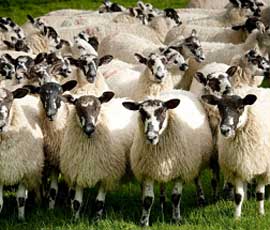On the way to cutting methane emissions

Current sheep genetic improvement programmes in Wales could help reduce methane emissions by 0.08% a year.
With the Welsh Assembly Government setting out to reduce emissions by 3% from 2011 and UK government setting a reduction target of 80% by 2050 in all sectors, agriculture is already heading along the right path.
Catherine Nakielny of KN Consulting, who has been working on developing a model to predict changes in methane emissions by genetic improvements in the Welsh flock, said genetic improvements could lead to permanent and cumulative reductions in methane emissions.
“A reduction in methane emissions of 0.08% a year is possible through current hill, upland and lowland breeding programmes, as long as ewe weights don’t get any bigger.”
Lamb growth rate, lamb muscle depth, lamb survival, ewe litter size and ewe longevity were all factors considered in the model. In hill flocks, traits expressed in the ewes showed particular scope for improvement, said Dr Nakielny, who was speaking at the Sheep Breeders Round Table last weekend.
“Increasing ewe litter size and longevity by genetic improvement over 10 years could reduce methane emissions by 8.8% and 3.8%, respectively. Lamb weights also have the potential to increase by 0.8kg and reduce days to finish a lamb by six days, which in turn could reduce methane emissions by 0.5% per tonne of carcass.”
Likewise in lowland flocks, increasing litter size could reduce emissions by 5.3% and improving lamb muscle depth and carcass weight could cut emissions by 2.7%. Weight of lamb reared has the potential to increase by 2.6kg and days to finish reduced by 1.4 days which could reduce methane emissions in lowland flocks by 1.8% just by genetic improvements.
“Reducing methane emission for every kg of output is possible as the model shows, by increasing efficiency of production through genetic improvements. However, management improvements can also help improve efficiency and cut methane emissions,” she explained.
The amount of methane produced by an animal depends on level of feed intake, feed quality and difference in feed conversion. Dr Nakielny said altering the diet by including high sugar grasses, plants extracts such as garlic and new varieties of cereal such as high lipid content oats could also help reduce methane.
“It’s important we look at reducing methane emissions, said Dr Nakielny, because it has a global warming potential 21 times higher than carbon dioxide. And it is something we can reduce by becoming more efficient by management and genetic improvements.”
